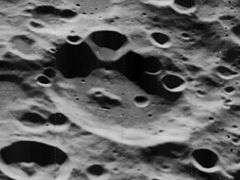Lodygin (crater)
Lodygin is a lunar impact crater to the southeast of the much larger crater Galois. To the east-northeast is the crater Paschen, and to the south-southwest is the immense Apollo.
 Oblique Lunar Orbiter 5 image | |
| Coordinates | 17.7°S 146.8°W |
|---|---|
| Diameter | 62 km |
| Depth | Unknown |
| Colongitude | 146° at sunrise |
| Eponym | Alexander N. Lodygin |
The outer rim of Lodygin has been heavily damaged along the western and northwestern sides, which lie closest to Galois. The rim along this face has been heavily modified and is overlain by multiple smaller craters. The remainder of the rim to the east and south are worn, but relatively intact. About half the original interior floor survives, and is marked only by a low central ridge offset to the south of the midpoint, and a few small or tiny impacts.
Satellite craters
By convention these features are identified on lunar maps by placing the letter on the side of the crater midpoint that is closest to Lodygin.
| Lodygin | Latitude | Longitude | Diameter |
|---|---|---|---|
| C | 15.9° S | 144.5° W | 30 km |
| F | 17.6° S | 142.8° W | 47 km |
| J | 18.5° S | 145.1° W | 25 km |
| L | 22.6° S | 145.4° W | 25 km |
| M | 19.2° S | 146.2° W | 14 km |
| R | 18.3° S | 149.2° W | 30 km |
References
- Andersson, L. E.; Whitaker, E. A. (1982). NASA Catalogue of Lunar Nomenclature. NASA RP-1097.CS1 maint: ref=harv (link)
- Blue, Jennifer (July 25, 2007). "Gazetteer of Planetary Nomenclature". USGS. Retrieved 2007-08-05.CS1 maint: ref=harv (link)
- Bussey, B.; Spudis, P. (2004). The Clementine Atlas of the Moon. New York: Cambridge University Press. ISBN 978-0-521-81528-4.CS1 maint: ref=harv (link)
- Cocks, Elijah E.; Cocks, Josiah C. (1995). Who's Who on the Moon: A Biographical Dictionary of Lunar Nomenclature. Tudor Publishers. ISBN 978-0-936389-27-1.CS1 maint: ref=harv (link)
- McDowell, Jonathan (July 15, 2007). "Lunar Nomenclature". Jonathan's Space Report. Retrieved 2007-10-24.CS1 maint: ref=harv (link)
- Menzel, D. H.; Minnaert, M.; Levin, B.; Dollfus, A.; Bell, B. (1971). "Report on Lunar Nomenclature by the Working Group of Commission 17 of the IAU". Space Science Reviews. 12 (2): 136–186. Bibcode:1971SSRv...12..136M. doi:10.1007/BF00171763.CS1 maint: ref=harv (link)
- Moore, Patrick (2001). On the Moon. Sterling Publishing Co. ISBN 978-0-304-35469-6.CS1 maint: ref=harv (link)
- Price, Fred W. (1988). The Moon Observer's Handbook. Cambridge University Press. ISBN 978-0-521-33500-3.CS1 maint: ref=harv (link)
- Rükl, Antonín (1990). Atlas of the Moon. Kalmbach Books. ISBN 978-0-913135-17-4.CS1 maint: ref=harv (link)
- Webb, Rev. T. W. (1962). Celestial Objects for Common Telescopes (6th revised ed.). Dover. ISBN 978-0-486-20917-3.CS1 maint: ref=harv (link)
- Whitaker, Ewen A. (1999). Mapping and Naming the Moon. Cambridge University Press. ISBN 978-0-521-62248-6.CS1 maint: ref=harv (link)
- Wlasuk, Peter T. (2000). Observing the Moon. Springer. ISBN 978-1-85233-193-1.CS1 maint: ref=harv (link)